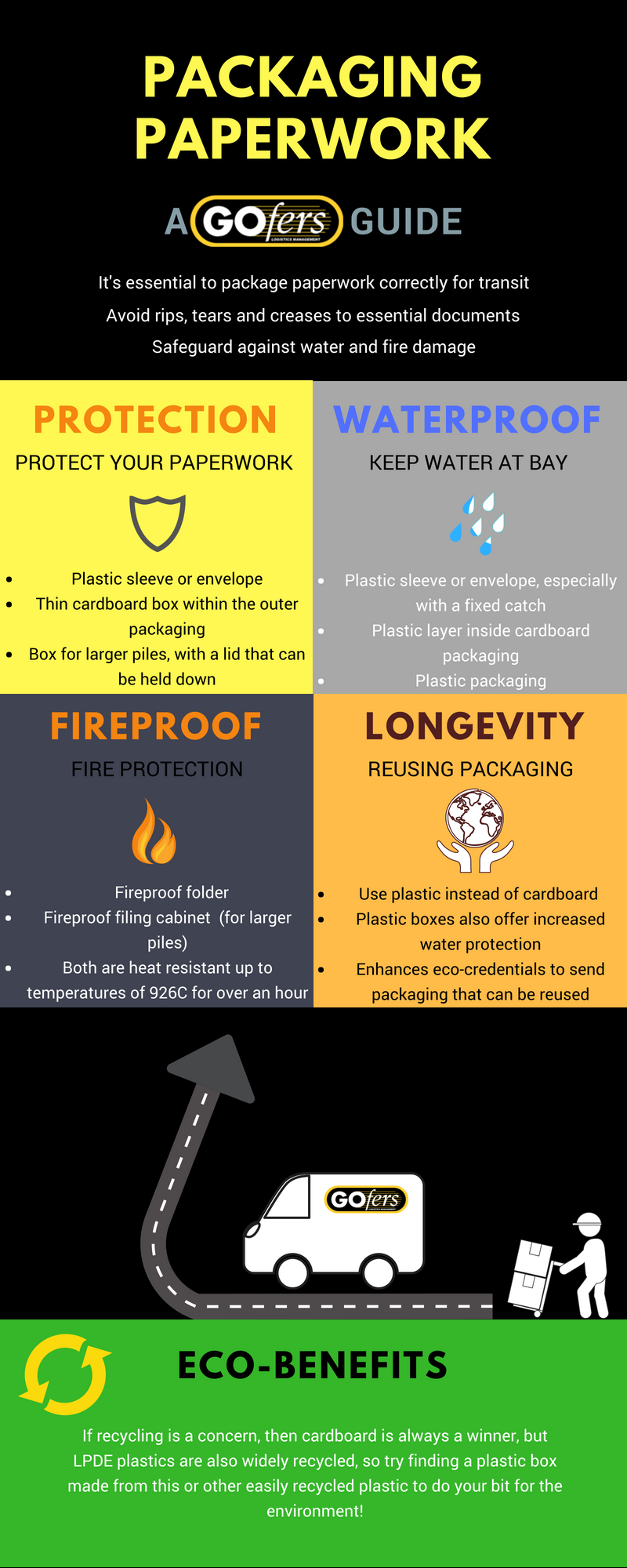
Paperwork. We all need it, not all of us want it; irrespective of whether you do or don’t, paper is still one of the most common items we courier on a daily basis. Much of it is crucial to pending transactions and procedures, so not only is it essential we deliver it on a same day delivery basis, it’s also essential it’s packaged correctly for transit.
It may seem simple – collate paperwork, wrap in something appropriate and deliver to the courier, but there’s more to it than that. The key essentials you should consider when wrapping paperwork for transit are:
- Protection/cushioning
- Waterproofing
- Fireproofing
- Longevity of packaging materials
Protection/Cushioning
Yes OK, paperwork can’t break in the same way as vase or glassware can, but it still needs protecting for the journey. You don’t want it to arrive with curled edges, folded corners or ripped edges.
The best thing to protect paperwork is a plastic sleeve or envelope (providing the paperwork pile is not too thick). This will protect the edges. If you can’t get one to fit, then either break the paperwork pile down into separate piles or look to use a hardboard folder.
Once you have the paperwork secure and protected, you need to package it. Brown paper is a good basic wrapping material, but it doesn’t offer a lot in the way of protection and it does rip easily. A thin cardboard box (you can buy them specifically for a number of paper sizes) will be a better bet, as the rigid sides will keep everything in line and it stands a better chance of staying intact in transit.
Larger piles of paperwork may need to be bound together and boxed for pallet transfer. If this is the case, choose a firm box with a lid you can easy hold down.
Waterproofing
Whilst all couriers will make every effort to protect their load from water damage, there is always a chance it can happen. Water and paper really don’t mix, so this is another reason to use a plastic sleeve or envelope where you can. Envelopes with fixed catches are especially good, as they stand a much better chance of keeping water out.
If your paperwork pile is too big for this, then it’s worth adding a plastic layer inside any cardboard packaging you use, even if that layer is just a plastic bag – it’s better than nothing. Or, you could use a plastic box – more expensive, but offers better protection all round.
Fireproofing
Again, this is something we really don’t want to happen but there’s always a risk. Fire is much harder to protect against, but fire-resistant file boxes are available. They’re the more expensive option but are typically resistant to heats of up to 926C for over an hour – so worth the investment if the paperwork is that valuable it absolutely cannot be lost!
Fire resistant filing cabinets are also available, for larger loads of paperwork.
Longevity of Packaging Materials
How long do you want your packaging materials to last? Do you want them to be reusable? If you’re couriering documents between offices, it’s surely better value for money to buy packaging (especially for larger paperwork piles) that they can use at the other end – such as plastic crates and boxes. Cardboard does have its eco benefits but will wear out quicker.
Of course, if your recipient is the end user, you may want to worry less about what they’ll do with the packaging unless it is to be packaged in a specific way as requested (such as gift boxes – unlikely for paperwork mind you). This decision really does depend on what you’ve decided for the other points as above – if you’ve gone for plastic over cardboard for protection and waterproofing purposes, then this has a longer reuse life by default.
Eco Benefits
If recycling is a concern, then cardboard is always a winner, but LPDE plastics are also widely recycled, so try finding a plastic box made from this or other easily recycled plastic to do your bit for the environment!









